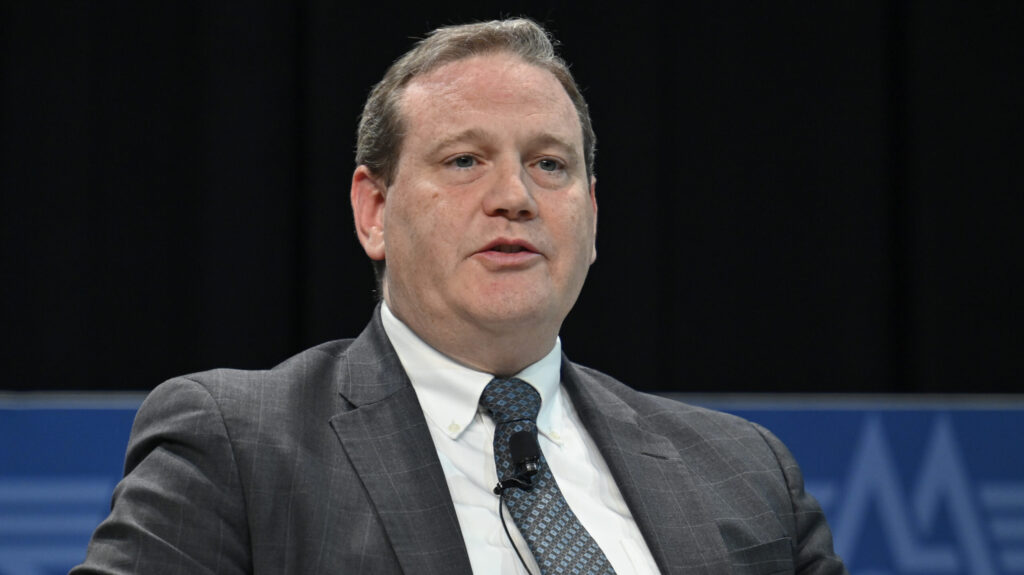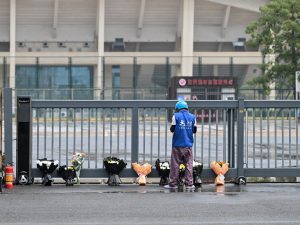
Andrew Hunter, assistant secretary of the Air Force for acquisition, technology and logistics, speaks during the panel discussion “Answering the Warfighters’ Needs” at the Air and Space Forces Association 2023 Warfare Symposium in Aurora, Colo., March 7, 2023. (U.S. Air Force photo by Eric Dietrich)
WASHINGTON — The US Air Force’s analysis of alternatives for a futuristic air refueler is wrapping up — but it’s not clear how much money will be available in future budgets to fund the tanker concept, according to the service’s outgoing acquisition chief.
“I think understanding what the [fiscal year 2026] budget is actually going to be is pretty significant to how the path forward” will play out, Andrew Hunter said in a Monday exit interview at the Pentagon. “And that is ultimately in their hands,” he added, referring to the Trump team.
Intended to perform refueling missions in contested air spaces, the Next Generation Air-refueling System (NGAS) has been envisioned with stealthy features to help it slip past enemy defenses, in contrast to current refuelers largely based on civilian aircraft designs. The Air Force updated its tanker strategy in spring 2023 to accelerate the NGAS platform, as well as craft a near-term buy for an interim tranche of refuelers until the NGAS aircraft can be fielded.
But plans have been in flux since. The Air Force has delayed funding the interim tranche of tankers, mostly because officials have not yet set a timeline for NGAS to enter service. And no design has been selected: Lockheed Martin pulled out of a partnership with Airbus for the interim buy, leaving the European conglomerate to face off against Boeing’s offer of more KC-46s and, potentially, Brazilian aerospace firm Embraer’s KC-390.
Officials have additionally sought to combine NGAS work with a review of the service’s separate Next Generation Air Dominance (NGAD) fighter, as the two platforms are expected to work in tandem. The fate of the NGAD fighter, along with the overall funding profile for the Air Force, have officially been left up to the Trump administration, although Breaking Defense first reported that an internal assessment of NGAD found the jet’s requirements fit the service’s needs.
RELATED: New Air Force review supports manned 6th-gen NGAD fighter concept
“The realization that we had is, you can’t look at these two things in isolation,” Hunter said. “You need an approach to Next Generation Air Dominance that is supported by your approach to aerial fueling. And you need an approach to aerial refueling that complements the tactical force that you’re buying, and enables it to carry forward the fight.”
He then stressed that the service’s approach to NGAS is “iterative” and constantly assesses trade-offs. He did not share details from the NGAS analysis of alternatives — which is still technically moving through final approvals at the Pentagon — but did say that the outlook for a near-term tanker deal is becoming more clear.
“It has substantially firmed up,” he said of the interim buy. “The big remaining open question, though, is what’s the budget?”
Post-Covid, A ‘Constant Process of Learning’ Between Industry, Government
Hunter came into his current role from the think tank world, but drew from extensive experience in government following stints on the Hill and at the Pentagon. And shortly after he took office in 2021, a crisis unfolded as inflation spiked in the wake of the pandemic, prompting widespread resistance among industry to contracts that could expose vendors to losses.
Much of the industry consternation centered around fixed-price agreements particularly for development contracts, where Boeing has served as a poster child for ill-conceived deals that have forced the aerospace giant to hemorrhage billions of dollars.
“A lot of these fixed-price contracts came out of an era where cost was kind of the big focus for the department, and so we did achieve some cost control,” Hunter said. “But there’s been a trade-off for that, which is we kind of lost the ability to have direct control over when a capability was getting delivered.”
Hunter said discussions will continue as a “constant process of learning” with industry, but that the Air Force can still pursue “big, fixed-price contracts” similar to those that govern programs like the troubled T-7A training jet — though only if the Air Force prepares for, and adjusts sufficiently to, the transition from development to production. A global environment characterized by rising tensions may also require different acquisition priorities as well, he said.
For some programs, an approach could be “we just have to field as soon as possible, and cost is secondary to that,” he said. “I think that’s also very valid, and that may be a really appropriate choice to make in the current environment where the risk of conflict is high.”
Ultimately, Hunter has come to believe, asking industry to commit to cost targets over a long period of time — as Boeing did on the T-7A in 2018, which entails 10 fixed-price production lots — is probably not reasonable going forward.
“10 lots of fixed-price aircraft, in an environment which, when the contract was awarded, where inflation had been two percent or less for like a decade, probably seemed entirely reasonable,” he said. “That’s probably too much risk for anyone to take as we look at it today.”

General Atomics Aeronautical Systems shows off its design for a Collaborative Combat Aircraft at AFA 2024 (Valerie Insinna/Breaking Defense)
Looking Back, And Ahead
Under the leadership of Air Force Secretary Frank Kendall, officials have sought to shepherd a number of changes for the Air Force and Space Force, from establishing certain “operational imperatives” to a sweeping overhaul dubbed “reoptimization.”
There were plenty of new, acquisition-specific initiatives under Hunter’s remit as well, including what the weapons buyer calls “next generation acquisitions.”
A critical element of that approach is reaching deeper into the supply chain. For example, the Air Force previously released a request for information to potential mission systems providers for the NGAS platform, and Hunter said the service’s larger embrace of mission systems government reference architectures for newer acquisitions is not just a pathway for eschewing vendor lock, but also for gaining a better view into the supply base.
“It also has a business purpose, which is a more direct and insightful relationship between the government and those key mission systems providers,” he said. “So we do understand where the money’s going, how it’s being used, and what the pace of technology development is and what the technology opportunities are directly.”
He noted that’s especially true for Collaborative Combat Aircraft (CCA), the Air Force’s budding effort to field drone wingmen that will join fighter jets in battle. Hunter considers the drone program as one of his signature achievements, which officials say will provide needed relief for an aging and shrinking fighter fleet that must be supplemented by an “affordable mass” of uncrewed systems.
By “marrying” the approach for mission systems, much of it derived from the NGAD program, to CCA that are “affordable, ab[le] to be produced in mass, and that we can sort of rapidly pivot and adopt new mission systems as they become available, I think that is something that is going to serve the nation very well.
“That is the new thing. Is DoD able to adopt the new thing?” he asked rhetorically. “The answer to me is yes, and we’ve done it, and you see it there.”
The Air Force has certainly hit rough patches in the acquisition world in the past few years, perhaps most notably represented by ballooning costs for a new ICBM. Reflecting on his tenure, Hunter said he’s the “kind of person who has 1,000 regrets every single day,” but generally speaking, he wished he was more quick with decision-making.
“In every case where we do something good,” he said, “I think to myself, ‘Well, why didn’t I do that earlier?’”
Set to leave office next week, the acquisition boss said he assumes the Air Force’s overarching strategy — defined by the “pacing challenge” of China — will not change much even under the new administration. Additionally, he emphasized that it’s critical for even disparate elements of the service to remain tightly integrated if officials want to achieve their goals.
And while he may “technically” retire, he still plans to remain active.
“You’ll still hear from me. I’ll still be around,” he said.





